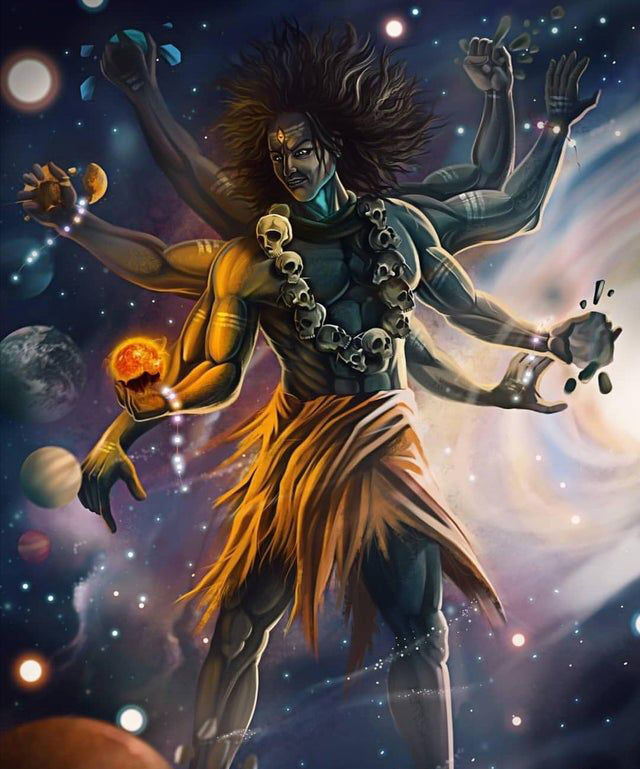
Lord Kala Bhairava, a formidable manifestation of Shiva, embodies the unyielding force of time and cosmic order. Revered across Hindu, Jain, and Buddhist traditions, he stands as the guardian of the universe's temporal flow, ensuring balance and justice. Depicted with a fierce demeanor, Kala Bhairava's iconography includes blazing eyes, a garland of skulls, and weapons that signify his role as the destroyer of evil and protector of righteousness. His presence is especially significant in the sacred city of Kashi (Varanasi), where he is venerated as the Kotwal, or chief guardian, maintaining spiritual discipline among devotees. Worship of Kala Bhairava bestows fearlessness, discipline, and liberation, guiding followers through the cycles of life and death with unwavering strength.
Who is Lord Kala Bhairava?
Lord Kala Bhairava is a fierce manifestation of Bhagwan Shiva, embodying the destructive and protective aspects of the divine. He is revered as the guardian of time and the enforcer of cosmic order. According to Hindu mythology, Kala Bhairava emerged from Shiva's wrath to punish Lord Brahma for his arrogance, symbolizing the destruction of ego and ignorance. He is considered a form of Shiva himself, representing the annihilating aspect that maintains balance in the universe. Kala Bhairava is also associated with the goddess Shakti, embodying divine feminine energy, and his consort is Bhairavi, highlighting the interplay between masculine and feminine forces in cosmic functions.
Kala Bhairava is depicted with a dark complexion, fierce expression, and multiple arms holding various weapons and symbols. His vahana (vehicle) is a dog, symbolizing loyalty and the ability to navigate darkness. He carries a trident, representing his power to destroy the three main obstacles in life; ignorance, ego, and desire. The drum signifies the rhythm of time and the universe, while the skull symbolizes the transient nature of life. He is often adorned with a garland of skulls, emphasizing his role in the cycle of life and death.
Significance of Lord Kala Bhairava
The literal translation of ‘Bhairava’ is fearful or terrible. Its interpretation is not quite the same. It generally means he is the deity who guards his worshippers from external enemies as well as from inner enemies like anger, lust, greed, and several other negative emotions. There is yet another interpretation of the name. ‘Bha’ denotes creation, ‘Ra’ for preservation, and ‘Va’ stands for destruction. Thereby, Bhairava is regarded as the ultimate godhead and merges all the forces of the universe.
Lord Kala Bhairava holds profound philosophical and spiritual significance within Hinduism. As the fierce manifestation of Shiva, he embodies the relentless force of time and the transformative power of destruction. His role as the guardian of time underscores the impermanence of worldly existence and the importance of spiritual discipline. By confronting fear and ego, worshippers seek his protection and the courage to transcend material limitations.
Kala Bhairava's veneration is particularly prominent in Shaivism and Tantric traditions. In regions like Varanasi, he is revered as the city's guardian, ensuring spiritual order. His influence extends to Buddhism, where he is recognized as a protector deity, illustrating his cross-cultural importance.
There are 64 Bhairavas in total, grouped into eight segments, each led by Kala Bhairava, the supreme ruler of time. These eight principal Bhairavas, known as the Ashta Bhairavas, each govern a direction of the universe and embody a specific power:
- Asitanga Bhairava: Enhances creativity and prosperity
- Ruru Bhairava: Helps overcome enemies
- Chanda Bhairava: Increases self confidence
- Krodha Bhairava: Empowers decisive action
- Unmattha Bhairava: Improves speech and communication
- Kapala Bhairava: Eliminates unproductive habits
- Bheeshana Bhairava: Removes negativity and wards off evil
- Samhaara Bhairava: Clears negative outcomes from past actions
Kala Bhairava is honored by Hindus, Jains, and Buddhists across India and Nepal. In Sri Lanka, he is worshipped as Bahirawa, the guardian of treasures. The Aghori sect regards him as their principal deity, while Kashmiri communities, especially those from Gorat, celebrate him during the Shivaratri festival. Bhairava’s worship centers on protection, transformation, and mastery over time and destiny.
Festivals dedicated to Kala Bhairava include Kalabhairav Jayanti, observed on the eighth day of the waning moon in the month of Kartik, typically falling in November or December. Devotees engage in fasting, night vigils, and special prayers to honor his role as the cosmic timekeeper and seek his blessings for protection and spiritual growth.
Iconography & Symbolism
Lord Kala Bhairava, a formidable manifestation of Bhagwan Shiva, embodies the annihilation of ego and the guardianship of sacred spaces.
Physical Appearance and Symbolic Elements
Kala Bhairava is depicted with a fierce visage, wide eyes, and protruding fangs, signifying his role as the destroyer of evil. His matted hair and garland of skulls (mundamala) represent the transcendence of worldly attachments and the impermanence of life. He wields a trident (trishula), symbolizing the destruction of the ego; a drum (damaru), denoting the rhythm of creation and destruction; a noose (pasha), indicating control over negative forces; and a skull, representing the annihilation of ignorance. His vahana (vehicle) is a dog, symbolizing loyalty and vigilance.
Art, Sculptures, and Temple Depictions
In art and sculpture, Kala Bhairava is often portrayed with four arms, holding his characteristic weapons. He is commonly depicted standing or dancing, emphasizing his dynamic nature. Temples dedicated to him, such as the Kal Bhairav temple in Ujjain and the Kilkari Bhairav temple in Delhi, feature prominent sculptures and images that highlight his fierce attributes. In Shaivite and Shakta temples across India, he is frequently positioned as a guardian deity at the entrance, underscoring his protective role.
Color Symbolism, Posture, and Mudras
Kala Bhairava is typically depicted with a dark complexion, symbolizing the vastness and depth of the cosmos. His posture is often dynamic, reflecting his active role in the destruction of evil and protection of the righteous. The Bhairava Mudra, associated with him, involves placing the right hand over the left, palms facing upward, resting in the lap. This gesture represents the union of masculine and feminine energies, signifying balance and the transcendence of duality.
Origin of Lord Kala Bhairava
Lord Kala Bhairava, a fierce aspect of Shiva, originates from a pivotal episode in the Shiva Purana. During a dispute over supremacy between Brahma and Vishnu, Shiva manifested as an endless pillar of light to reveal the truth. Vishnu admitted his limitations, but Brahma, driven by pride, falsely claimed victory. In response, Shiva created Kala Bhairava from his third eye. Bhairava severed Brahma’s fifth head, a decisive act that symbolizes the eradication of arrogance and falsehood. This event left Brahma with four heads and burdened Bhairava with the sin of Brahmahatya, compelling him to wander with Brahma’s skull until his absolution in Varanasi.
This narrative underscores the principle that even divine beings are subject to the laws of karma and must atone for their actions. Kala Bhairava’s journey as a penitent wanderer reflects the necessity of humility and the transformative power of penance. His eventual liberation in Varanasi, one of Hinduism’s holiest cities, highlights the city’s spiritual significance as a place of redemption.
Kala Bhairava’s role extends beyond this myth. He is revered as the guardian of time (Kala) and the protector of sacred spaces (Kshetrapalaka), ensuring order and discipline in the spiritual realm. His presence at temple entrances and his worship during midnight rituals reflect his authority over transitions, boundaries, and the unseen. These themes resonate with broader Hindu philosophy, where the maintenance of dharma and cosmic balance is central, as seen in texts like the Mahabharata and other Puranas.
The story of Kala Bhairava illustrates the importance of truth, humility, and accountability, while his worship reinforces the need for vigilance, discipline, and respect for spiritual law. Through his fierce yet just nature, Kala Bhairava embodies the principles that uphold cosmic order and spiritual integrity.
Legends and Stories
The Decapitation of Brahma and the Destruction of Ego
Many legends feature Lord Bhairava, the fierce and terrifying aspect of Bhagwan Shiva, who is often invoked to destroy arrogance and uphold cosmic order. One of the most famous tales, found in the Shiva Mahapurana, centers on a dispute between Brahma, Vishnu, and Shiva about who is the Supreme Creator of the Universe.
Bhagwan Vishnu asked Brahma who the Supreme Creator was. Brahma, honored as the Creator, became egoistic, especially since he had five heads like Shiva and believed he could match Shiva’s powers. He began to mimic Shiva’s work and interfere with his tasks. Shiva, initially tolerant, grew impatient with Brahma’s meddling. In response, Shiva broke a tiny nail from his finger and threw it. This nail transformed into Kaala Bhairava, who immediately proceeded to Brahma and cut off one of his heads. This act is why Bhairava is often depicted holding Brahma’s skull.
Another version of the story says that when Brahma humiliated Shiva, then Shiva assumed the form of the ferocious Bhairava, leaping from his Third Eye to sever Brahma’s fifth head. Decapitating Brahma, a Brahmin, was considered the gravest sin (Brahmahatya). As penance, Bhairava wandered the universe as a naked beggar, with Brahma’s skull (kapala) stuck to his hand, using it as a begging bowl. His sin was absolved only when he reached the sacred city of Varanasi (Kashi), where the skull finally fell from his hand, signifying liberation.
Through this act, Bhairava humbled Brahma, ending his ego and granting him immediate enlightenment. Brahma, now appreciative, bowed before Bhairava and vowed to work for the benefit of the Universe.
The Birth of Bhairava from Kali’s Anger
Another fascinating legend describes how Bhagwan Shiva conceived Bhairava through the divine intervention of Goddess Parvati. There was once a ferocious asura named Dahurasuran, who, after rigorous penance, received a boon that he could only be killed by a woman. To vanquish him, Parvati assumed the form of Kali and succeeded in her mission. However, after the battle, Kali’s anger manifested as a child. She nourished this child with her milk.
Witnessing this, Bhagwan Shiva appeared and merged both Kali and the child into himself, giving rise to the avatar of Bhairava. From this form, Shiva manifested as the eight Ashtanga Bhairavas. Since Kali’s manifestation was the reason for Bhairava’s existence, he is occasionally referred to as her son.
Guardian of the Shakti Peethas
Following the self-immolation of Sati, Shiva carried her corpse and performed the Tandava, the dance of destruction. To pacify him, Vishnu used his Sudarshan Chakra to dismember Sati’s body, scattering her parts across the Indian subcontinent and creating the sacred Shakti Peethas. Lord Bhairava was appointed as the guardian deity of these sites, ensuring their sanctity and protecting devotees.
Protector and Kotwal of Varanasi
Lord Bhairava is especially revered as the Kotwal (chief guardian) of Varanasi. It is believed that without his permission, no one can reside in or even enter the city. He maintains spiritual order, punishes wrongdoers, and ensures the city’s sanctity. His temple in Varanasi is a major pilgrimage site, attracting devotees seeking protection and liberation.
These legends collectively highlight Lord Bhairava’s role as the destroyer of arrogance, the enforcer of humility, the guardian of sacred sites, and the protector of spiritual order. Through his fierce forms and actions, Bhairava upholds dharma and guides souls toward spiritual liberation.
Spiritual Lessons from Lord Kala Bhairava
Lord Kala Bhairava represents the fierce aspect of Shiva and stands as a guardian of time, justice, and spiritual discipline. His tales offer several direct spiritual and moral lessons.
Kala Bhairava teaches the importance of humility by subduing Brahma’s ego, emphasizing that pride leads to downfall and that true enlightenment comes from humility and self-realization. He acts as a destroyer of negative qualities like anger, lust, and greed, guiding devotees to conquer inner enemies and purify their minds. His role as the guardian of the universe’s directions underlines the value of protection, vigilance, and responsibility, reminding individuals to defend righteousness and support the vulnerable, especially women and the meek.
The story of Bhairava’s penance after severing Brahma’s head highlights the inevitability of facing the consequences of one’s actions, regardless of status or power. It underscores the necessity of accepting responsibility and seeking redemption through sincere effort and self-discipline.
Kala Bhairava’s association with time instructs devotees to respect and utilize time wisely, avoiding wasteful pursuits and focusing on meaningful, constructive actions. Worship of Bhairava foster time management, clarity, and purposeful living.
His connection with dogs, considered his vahana, encourages compassion and care for all beings, reinforcing the spiritual merit of kindness and service to others.
Overall, the lessons from Kala Bhairava’s legends inspire humility, self-control, accountability, wise use of time, protection of the weak, and compassion, forming a foundation for spiritual growth and ethical living.
Puja Vidhi at Home
Performing a Kaal Bhairav Puja at home is a spiritually enriching practice that invokes protection, clarity, and liberation from negative influences. The following guide outlines the essential materials, step-by-step procedure, and chanting practices to conduct the puja effectively.
Required Materials
General Puja Items:
- Haldi (turmeric), Kumkum (vermilion), Sandalwood paste
- Cotton wicks, Molly thread, Akshat (unbroken rice)
- Gangajal (Ganges water), Camphor, Incense sticks .
- Honey, Sugar, Milk, Curd, Ghee, Panchamrit .
- Fresh flowers, Fruits, Sweets, Mango leaves.
Specific to Kaal Bhairav Puja:
- Lemon, Black gram (Kala urad), Black sesame seeds
- Black cloth, Blue flowers, Mustard oil
- Batuk Bhairav Yantra, Kusha grass ring
- Navgraha sticks, Havan samagri (herbs and powders)
Step-by-Step Home Puja Guide
Preparation:
- Cleanse the puja area and take a bath.
- Wear clean, preferably white or light-colored clothes.
- Arrange all puja items neatly.
Kalash Sthapana:
- Place a Kalash (sacred pot) filled with water and mango leaves.
- Invoke deities like Gauri, Ganesh, and Navgraha into the Kalash.
Sankalpa (Resolution):
Declare your intent for performing the puja, seeking blessings for protection and spiritual growth.
Ganesh Puja and Abhishek:
- Worship Lord Ganesh to remove obstacles.
- Perform Abhishek (ritual bathing) of the Kaal Bhairav idol or Yantra with Panchamrit and water.
Navgraha Puja:
- Offer prayers to the nine planetary deities to harmonize planetary influences.
- Kaal Bhairav Invocation:
- Light mustard oil lamps.
- Offer black sesame seeds, black gram, and blue flowers.
- Apply sandalwood paste and Kumkum to the idol or Yantra.
Mantra Japa:
Chant the Kaal Bhairav mantra:
'Om Hreem Aapaduddharanaay Kuru Kuru Swaha'
Repeat the mantra 108 times using a Rudraksha mala.
Aarti and Pushpanjali:
- Perform Aarti by waving camphor flame in a circular motion.
- Offer flowers (Pushpanjali) while chanting the deity's name.
Prasad Distribution:
Distribute the offered sweets and fruits among family members.
Charity and Dakshina:
Conclude the puja by donating food or essentials to the needy, especially feeding dogs, which is considered auspicious.
Chanting and Aarti Process
Mantra Chanting:
Chant the primary mantra with devotion, focusing on the deity's form and attributes.
Aarti:
- Sing the Kaal Bhairav Aarti, accompanied by the ringing of bells and clapping.
- Wave the camphor flame in a clockwise direction in front of the deity.
Post-Aarti:
- Apply the sacred ash (Vibhuti) on the forehead.
- Consume a portion of the Prasad and share the rest with others.
Regularly performing this puja, especially on Kalashtami days, invokes Lord Kaal Bhairav's blessings, ensuring protection, prosperity, and spiritual advancement.
Kala Ashtami: Puja Vidhi
Kala Ashtami is observed each month on the eighth day (Ashtami Tithi) of Krishna Paksha, the waning phase of the moon, in the Hindu lunar calendar. Dedicated to Bhagwan Kala Bhairava, this day is considered especially auspicious for his worship. There are twelve Kala Ashtami observances annually, with the Ashtami following the full moon (Purnima) of this month regarded as the most favorable time to offer prayers to Kala Bhairava.
- Devotees who fast on this day should wake up early and cleanse themselves by taking a bath.
- Offer coconut, rice, sandalwood, roses, milk, and nuts to the Lord Kala Bhairava idol.
- Afterwards, light incense sticks and a diya (lamp) with mustard oil while reciting mantras devoted to Bhagwan Shiva.
- At night time, the worshippers present water to the moon and break their fast
- Those who are fasting, generally keep away from drinking alcohol, consuming tobacco, and eating non-vegetarian food among others.
- Devotees need to be celibate during the fasting duration.
Mantras Dedicated to Kala Bhairava
Kaal Bhairav Mool Mantra
Om Hraam Hreem Hroom Hrime Hroum Ksham Kshetrapaalaaya Kaala Bhairavaaya Namah
Meaning:
Salutations to Lord Kala Bhairava, the guardian of the sacred region, who embodies the transformative power of time.
Benefits:
Chanting this mantra instills courage, dispel fear, and protect from negative energies. It aids in overcoming obstacles and promotes spiritual growth.
Kaal Bhairav Beej Mantra
Om Aim Hreem Kleem Shri Batuk Bhairavaaya Namah
Meaning:
I bow to Lord Batuk Bhairava, the youthful form of Bhairava, who grants protection, purification, and spiritual growth.
Benefits:
Regular recitation help in managing time effectively, attracting wealth, and settling legal disputes. It also aids in overcoming difficulties and curing diseases.
Kaal Bhairav Gayatri Mantra
Om Kaalakaalaaya Vidmahe Kaalaatheethaaya Dheemahi Tanno Kaala Bhairavah Prachodayaat
Meaning
: We meditate upon the supreme Kala (Time) and the timeless Kaala Bhairava. May he inspire and enlighten us.
Benefits:
Chanting this mantra free individuals from sorrow, attachment, and confusion. It helps in achieving success in targeted goals and provides protection against enemies and negative thoughts.
Kala Bhairava Ashtakam
Devarajasevyamaanapaavanaanghripankajam Vyaalayajnasuutramindushekaram Kripakaram Naradaadiyogivrindavanditam Digambaram Kaashikapuraadhinaathakaalabhairavam Bhaje
Meaning:
I worship Kala Bhairava, the lord of Kashi, whose lotus feet are revered by Indra, who wears the sacred thread of serpents, who is adorned with the moon, who is compassionate, and who is worshipped by sages like Narada.
Benefits:
Reciting the Kala Bhairava Ashtakam grant knowledge, detachment, and liberation. It removes grief, attachment, and greed, bringing one closer to the feet of Kala Bhairava.
Benefits of Worshipping Lord Kala Bhairava
Worship of Lord Kala Bhairava offers a range of benefits that touch spiritual, mental, and material aspects of life. Spiritually, it fosters inner strength, clarity, and a deeper connection with the divine. Mentally, it helps reduce fear, anxiety, and negative thoughts, promoting peace and focus. Materially, devotees experience protection from harm, obstacles are removed, and progress in personal and professional life becomes smoother. Worship also encourages discipline and wise use of time, leading to greater efficiency and success.
Key benefits include:
- Enhanced spiritual growth and awareness
- Removal of fear and negative energies
- Protection from dangers and evil influences
- Improved mental clarity and focus
- Relief from anxiety and stress
- Better time management and discipline
- Resolution of financial and legal problems
- Progress in career and personal endeavors
- Support in overcoming obstacles
- Increased compassion and kindness toward others
Temples Dedicated to Lord Kala Bhairava
Temples dedicated to Lord Kala Bhairava are prominent in India and Nepal, showcasing diverse architectural styles and rich histories. The Kala Bhairava Temple in Varanasi is a key spiritual site, revered as the city’s guardian. Other major temples include the Kal Bhairav Temple in Ujjain, Kilkari Bhairav Temple in Delhi, and the Bhairavnath Temple in Kedarnath. South India hosts the world’s largest Bhairava statue in Tamil Nadu and important temples in Karnataka and Tamil Nadu, such as the Kalabhairaveshwara Temple and Kala Bhairava Cholapuram Temple. Nepal’s Kal Bhairav and Akash Bhairav temples are central to Newar devotion.
Architecturally, these temples range from North Indian shikharas to Nagara styles, often featuring fierce idols symbolizing protection and destruction of evil. The major festival, Bhairava Ashtami, is celebrated with pilgrimages, prayers, and rituals, especially in Varanasi where devotees visit eight Ashta Bhairava temples. These temples and festivals highlight Kala Bhairava’s spiritual significance and cultural heritage.
Presence in Other Traditions
In Vajrayana Buddhism, Kala Bhairava appears as Vajrabhairava or Yamantaka, a wrathful form of Manjushri. He is central to advanced tantric practices in Tibetan Buddhism, representing the destruction of ignorance and mastery over death. His rituals focus on removing obstacles and protecting practitioners from spiritual harm.
In Jainism, Bhairava is worshipped at sites like Nakoda as a guardian spirit. Jain practices emphasize his protective role while adapting rituals to align with nonviolence and purity, excluding offerings like meat or alcohol.
In Southeast Asia, Bhairava is especially important in Nepal, where his temples are major pilgrimage sites for both Hindus and Buddhists. In Indonesia, traces of his worship appear in ancient temples, linking him to royal power and spiritual authority.
Comparative mythology connects Bhairava to transformative figures such as Loki and Prometheus, who challenge norms and drive change, symbolizing the force that enables spiritual progress and renewal.
Rudra Centre’s Kala Bhairava Products & Puja Services
Kaal Bhairav Brass Murti
A 4.7-inch brass idol of Lord Kaal Bhairav, ideal for home or altar worship. Symbolizes protection, success, and victory over negativity and is also worshipped for safe travel.
Bhairav Locket in Pure Silver
A silver locket featuring Lord Bhairav, designed for personal protection, victory over obstacles, and material success. Suitable for daily wear.
Shree Kaal Bhairav Yantra
A sacred geometric yantra etched on brass, available in various formats. Used for worship and installation at home or work to attract protection, good time management, and spiritual growth.
Tripur Bhairavi Puja & Yagna (11000 chants)
A special puja dedicated to Tripur Bhairavi, another aspect linked to Kala Bhairava, focusing on spiritual empowerment and removal of obstacles. Includes live video options and ritual documentation.
Kaal Bhairav Puja Vidhanam (11000 chants)
A comprehensive Vedic ritual performed by expert priests for blessings, protection from negativity, removal of obstacles, and fulfillment of wishes. Includes live participation options and energized prasad items sent to the devotee.
Conclusion:
The Eternal Guardian of Transformation
Lord Kala Bhairava embodies the relentless force that shatters illusion, dispels fear, and upholds the sacred order of the universe. He is not only a fierce protector but also a vigilant guide, urging seekers to confront their deepest shadows and rise above ego and ignorance. His presence commands respect for time, discipline in action, and unwavering commitment to truth.
Through devotion to Kala Bhairava, one gains more than just protection, one awakens to inner strength, clarity of purpose, and the courage to face life’s toughest challenges. His path transforms uncertainty into wisdom, weakness into resilience, and chaos into harmony.
To walk with Kala Bhairava is to embrace a journey of fearless self-discovery, ethical living, and profound spiritual growth, anchored in the certainty that true transformation begins with humility and ends in liberation.


-in-Astrology.jpg)
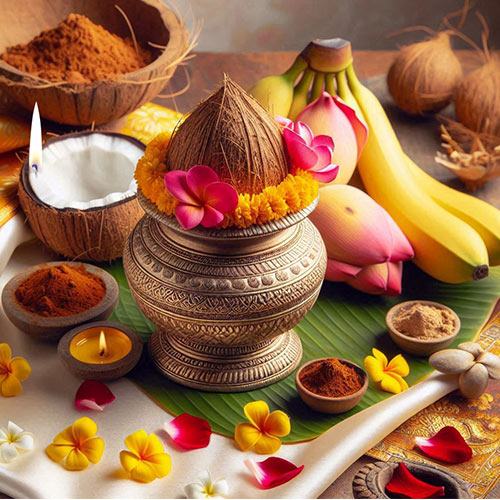

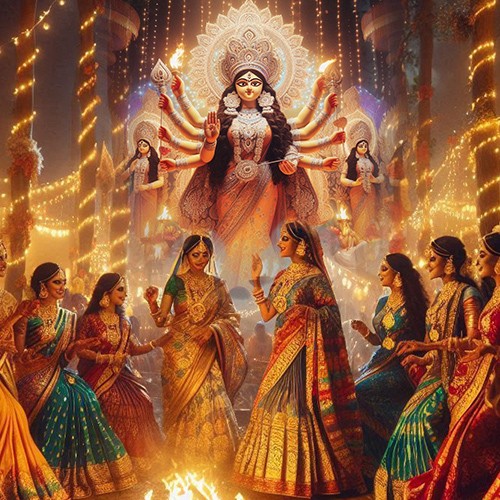
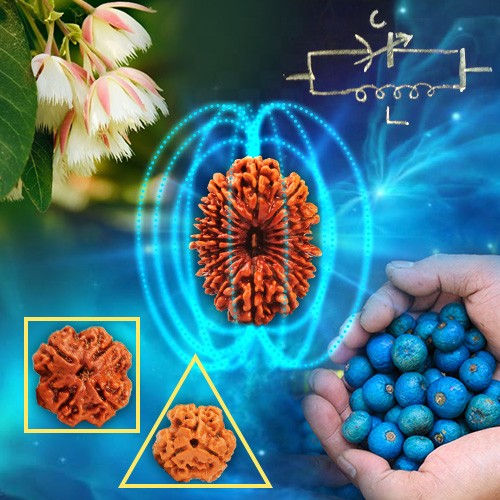

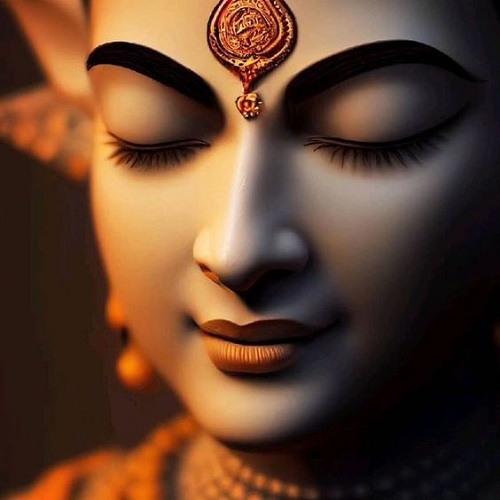
.jpg)
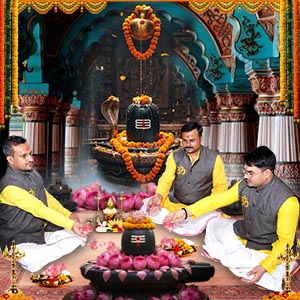
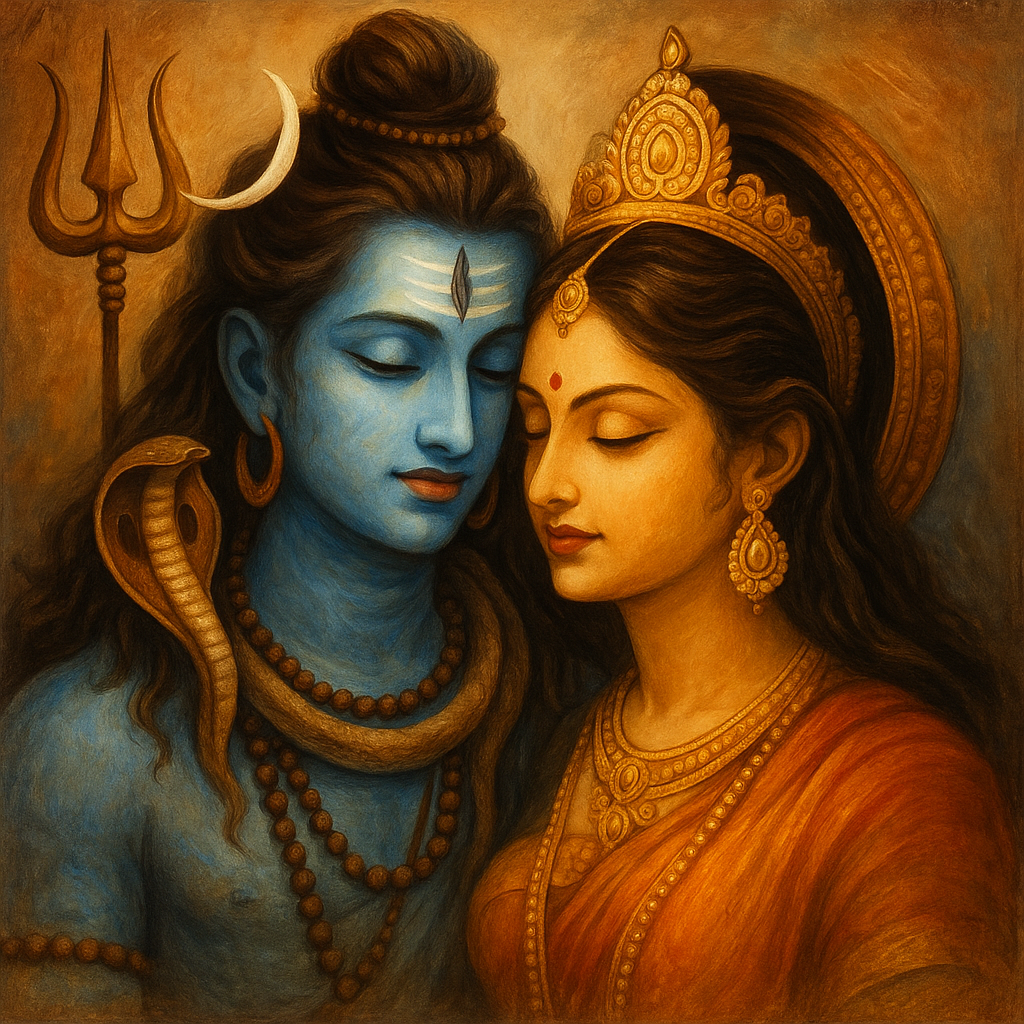
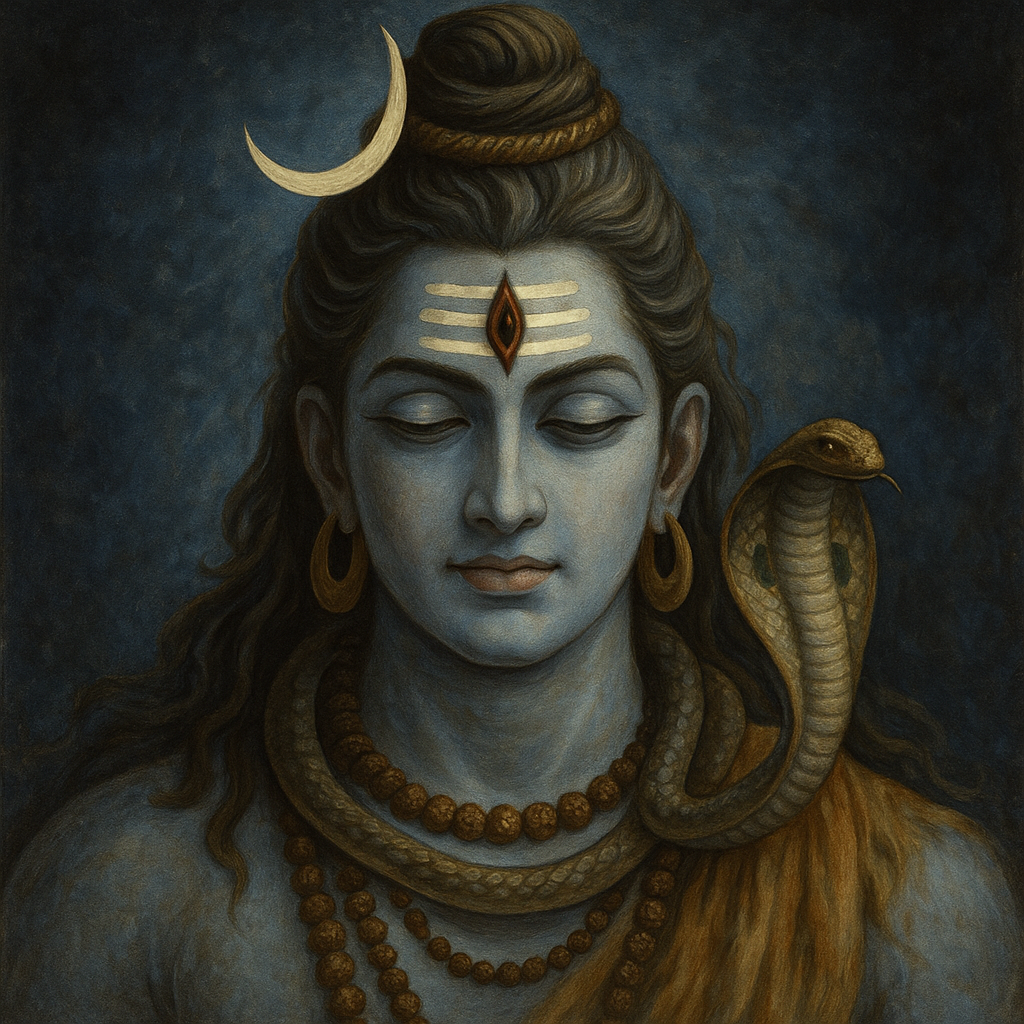
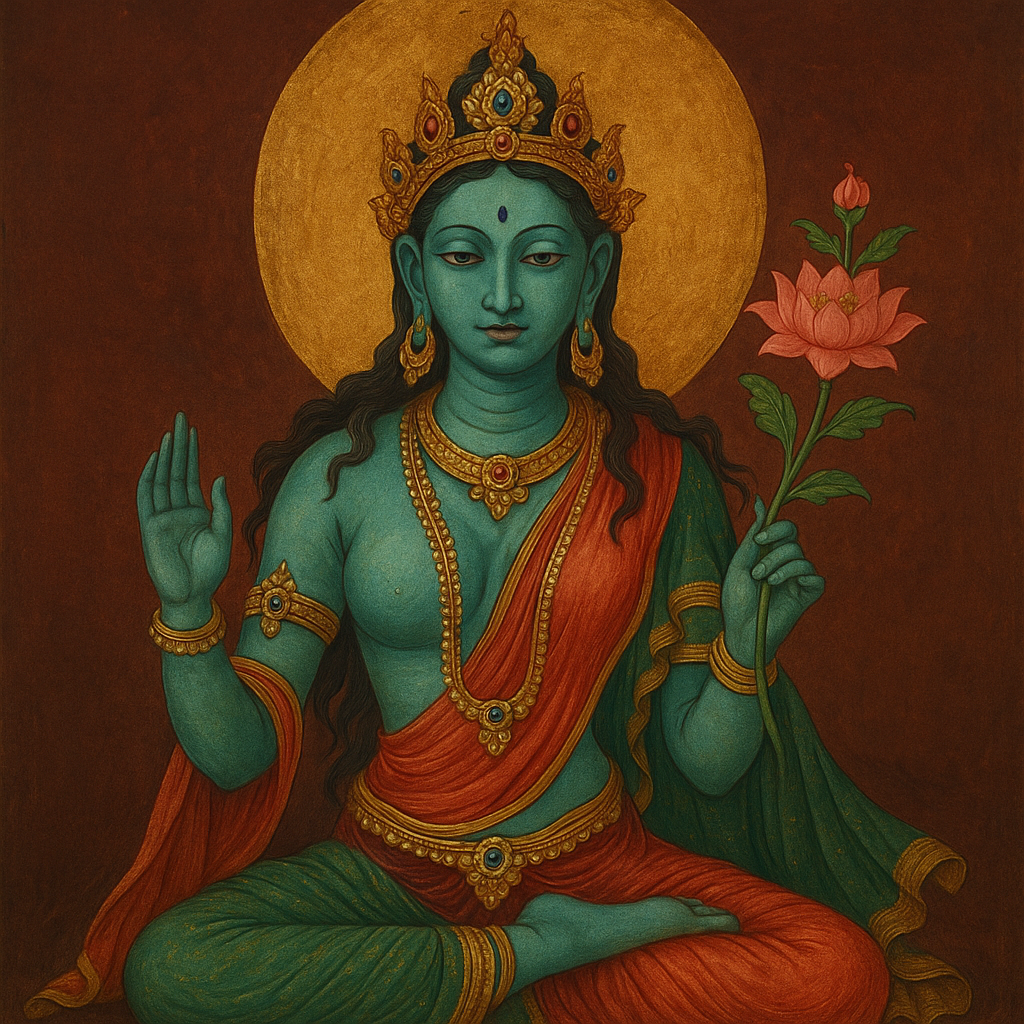
Geetha Gopalakrishna
|August 14, 2024
Thankyou for the article Informative article about Bhairava Swamy Om namah shivaya hara hara Mahadev
shyamala
|January 31, 2024
very powerful god
Bhavish Ramkissoon
|January 7, 2024
Good articles about Lord Bhairava ❤️🙏 Thank you ❤️ Har Har Mahadev ❤️🙏